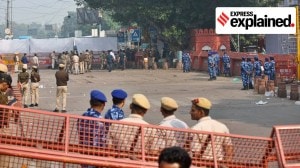Decode Politics: Why paddy again has Punjab govt in muddy waters
Parties trade charges, CM Mann approaches Centre as lack of storage space, ‘low yield’ from new varieties hit procurement
 Rice millers are not willing to pick up more as paddy stored in the open, due to lack of storage space, may face damage, such as becoming overdried, resulting in lesser weight. (Express Archives/ representational)
Rice millers are not willing to pick up more as paddy stored in the open, due to lack of storage space, may face damage, such as becoming overdried, resulting in lesser weight. (Express Archives/ representational)With Punjab staring at a glut of paddy at mandis due to slow procurement, it is threatening to snowball into a major problem for the state government. On Monday, Punjab Chief Minister Bhagwant Mann met Union Minister of Consumer Affairs, Food and Public Distribution Pralhad Joshi on the issue.
After the meeting, the Union Food Ministry issued a statement saying the Centre would procure 185 lakh metric tonnes (LMT) of paddy from Punjab in the kharif marketing season of 2024-25, and has made adequate arrangements, including storage capacity, to meet the procurement target. It also said that paddy procurement in the state commenced from October 1 “and is proceeding smoothly”.
The ministry said a detailed plan had been prepared to provide about 40 LMT of storage space by liquidating previous stocks of wheat as well as that of rice from the covered godowns available in Punjab, by December 2024.
What is at the heart of the issue?
The lack of storage space in the Food Corporation of India’s (FCI) godowns, and the arrival of non-recommended paddy hybrid varieties like 7301, 7501 and 468 as well as government-recommended PR-126 at mandis, has precipitated the crisis in the state.
Rice millers are not willing to pick up more as paddy stored in the open, due to lack of storage space, may face damage, such as becoming overdried, resulting in lesser weight. They have also expressed concern that the hybrid varieties are yielding lower rice, falling short of the government’s specifications, while even PR-126 only leads to 62 kg of rice from every quintal of paddy against 67 kg for other varieties. They say they are facing a prospective loss of Rs 300 on every quintal.
As per the Vice-Chancellor of Punjab Agricultural University, Dr S S Gosal, there was no issue of yield with the PR-126 variety, but with other hybrid varieties, which were not recommended by it.
The government requires rice millers to supply 67% rice to the government from milled paddy. However, the millers say, with these varieties, the target is impossible without financial losses.
How much paddy has been procured?
According to Punjab Mandi Board records, different state agencies have procured 3.73 LMT of paddy out of the total 4.57 LMT that arrived at the mandis, but only 20,000 tonnes of paddy has left the mandis. The government must shift the procured paddy to rice mills, after which it can take possession of the rice.
Why is it a pressing political issue?
Paddy is not a staple diet of Punjab and is grown in the state extensively because the Centre gives MSP on the produce. Every year, paddy procurement by the Centre for its Public Distribution System pool fetches over Rs 40,000 crore to the state farmers. Besides keeping the rural economy healthy, it also earns the state Rural Development Fund, a tax levied on the Centre by the state, being its procurement agency, to the tune of 3% of the total purchase.
With farmers already agitating over several issues in Punjab, a failure to lift large quantities of paddy will add to their discontent. Officials also fear a law and order situation, with Chief Secretary Anurag Verma writing to the Centre last month warning of the same (Verma has since been removed from the post).
In a similar situation in Punjab dating back to the kharif marketing season of 2000, when a Shiromani Akali Dal-BJP government was in power, farmers had unloaded their produce on the roads as mandis were filled to the brim, with millers reluctant to procure due to high content of moisture in the paddy.
What has the state government done to contain possible fallout?
The Aam Aadmi Party government led by Bhagwant Mann has come under criticism for “waking up” late and realising only near the procurement season that the godowns were full. Farmers led by the Samyukta Kisan Morcha have threatened black flag demonstrations against AAP MLAs and ministers should they visit any mandi, and to gherao CM Mann’s residence on October 18 if the issue is not sorted.
After meeting Union minister Joshi in Delhi Monday, Mann said he had pressed upon the Centre that procurement of paddy was like a “festival” in the state, and that not just the economy of the state but also the food security of the country depended on it.
He also reminded the Centre of the targets of lifting 185 LMT of paddy of varieties KMS 24-25, and delivery of 125 LMT of fortified rice. With only about 7 LMT storage space left, Mann said, he urged Joshi to ensure smooth procurement and movement, to ensure liquidation of at least 20 LMT foodgrains per month from the state till March 31, 2025.
Mann said the Union minister had promised to transport 120 LMT paddy from the state to other states by March 2025.
What has the Opposition said on the issue?
Attacking the AAP government, Leader of the Opposition and Congress leader Partap Singh Bajwa has said Punjab was expecting about 185 LMT of paddy to arrive in mandis, and still the government, including the Centre, did not prepare for the lack of space, with previous stocks not cleared.
Doubting Mann’s claim that the Centre had assured that the entire space would be cleared by March 1, saying this was impossible in four months, Bajwa has alleged a “conspiracy” by the BJP and AAP to “destroy Punjab’s economy”, by forcing farmers to go in for distress sale.
The Congress has also raised the fact that PR-126 and similar varieties of paddy were sowed by farmers at the instance of CM Mann, though they yield “about 5 kg per quintal less rice”, and predicted losses to rice millers to the tune of Rs 6,000 crore.
Defending the PR-126 variety, AAP chief spokesperson Neel Garg claimed the promotion of it by the government had resulted in savings of Rs 477 crore worth of electricity and 4.82 billion cubic meters of water.
Punjab BJP vice-president Fateh Jung Singh Bajwa claimed that while the Centre has already disbursed funds to the state government for the purchase of paddy, the state government had failed to lift the crop. “The fault lies with the state government and not the Centre,” he said.
He also underlined that farmers had sowed the PR-126 variety at the instance of the Mann government.



- 01
- 02
- 03
- 04
- 05




























